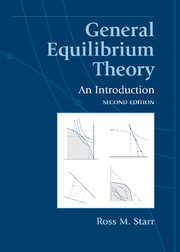Book contents
- Frontmatter
- Contents
- List of illustrations
- Introduction to the second edition
- Preface to the second edition
- Preface to the first edition
- Table of notation
- Table of assumptions
- A General equilibrium theory: Getting acquainted
- B Mathematics
- 6 Logic and set theory
- 7 RN: Real N-dimensional Euclidean space
- 8 Convex sets, separation theorems, and nonconvex sets in RN
- 9 The Brouwer Fixed-Point Theorem
- C An economy with bounded production technology and supply and demand functions
- D An economy with unbounded production technology and supply and demand functions
- E Welfare economics and the scope of markets
- F Bargaining and equilibrium: The core
- G An economy with supply and demand correspondences
- H Standing on the shoulders of giants
- Bibliography
- Index
8 - Convex sets, separation theorems, and nonconvex sets in RN
from B - Mathematics
Published online by Cambridge University Press: 05 June 2012
- Frontmatter
- Contents
- List of illustrations
- Introduction to the second edition
- Preface to the second edition
- Preface to the first edition
- Table of notation
- Table of assumptions
- A General equilibrium theory: Getting acquainted
- B Mathematics
- 6 Logic and set theory
- 7 RN: Real N-dimensional Euclidean space
- 8 Convex sets, separation theorems, and nonconvex sets in RN
- 9 The Brouwer Fixed-Point Theorem
- C An economy with bounded production technology and supply and demand functions
- D An economy with unbounded production technology and supply and demand functions
- E Welfare economics and the scope of markets
- F Bargaining and equilibrium: The core
- G An economy with supply and demand correspondences
- H Standing on the shoulders of giants
- Bibliography
- Index
Summary
DefinitionA set of points S in RN is said to be convex if the line segment between any two points of the set is completely included in the set, that is, S is convex if x, y ∈ S implies {z | z = αx + (1 - α)y, 0 ≤ α ≤ 1} ⊆ S.
S is said to be strictly convex if x, y ∈ S, x ≠ y, 0 < α ≤ 1 implies αx + (1 - α)y ∈ interior S.
The notion of convexity is that a set is convex if it is connected, has no holes on the inside, and has no indentations on the boundary. Figure 8.1 displays convex and nonconvex sets. A set is strictly convex if it is convex and has a continuous strict curvature (no flat segments) on the boundary.
Properties of convex setsLet C1and C2be convex subsets of RN. Then
C1 ∩ C2is convex,
C1 + C2is convex,
C1is convex.
Proof See Exercise 8.1. QED
The concept of convexity of a set in RN is essential in mathematical economic analysis. This reflects the importance of continuous point-valued optimizing behavior. To understand the importance of convexity, consider for a moment what will happen when it is absent. Suppose widgets are consumed only in discrete lots of 100. The insistence on discrete lots is a nonconvexity. Suppose a typical widget eater at some prices to be indifferent between buying a lot of 100 and buying 0.
- Type
- Chapter
- Information
- General Equilibrium TheoryAn Introduction, pp. 91 - 98Publisher: Cambridge University PressPrint publication year: 2011



